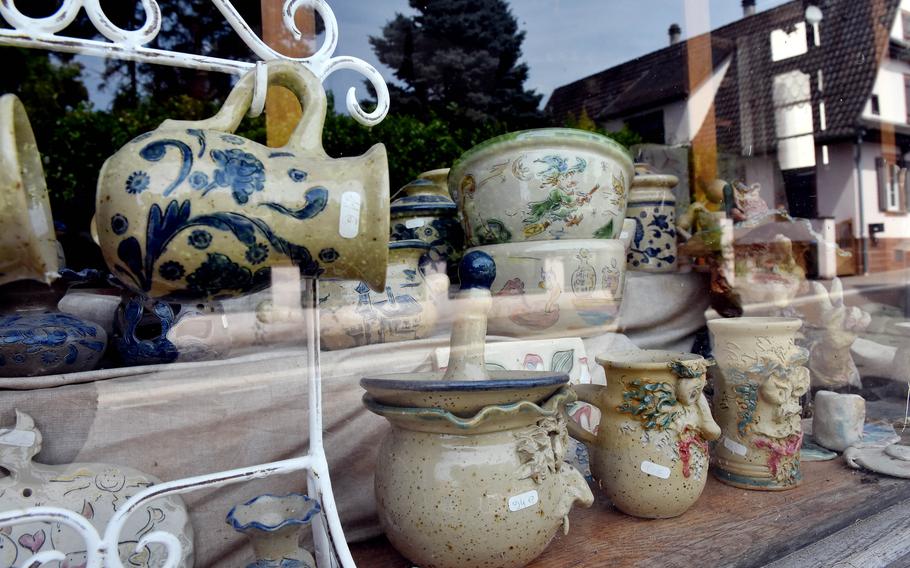
Ecletic pottery works are displayed in the window of Pascal Stecher’s tiny workshop in Betschdorf, France. Stecher is fascinated by witches and dragons and often includes their images on his pottery. (Jennifer H. Svan/Stars and Stripes)
In the northeast of France’s clay-rich Alsace region is the village of Betschdorf, which has been producing its signature salt-glazed, gray-and-blue pottery for hundreds of years.
But only a handful of local artisans remain, making this a good time to go see how the pottery is made and pick up a few pieces while there’s still an opportunity.
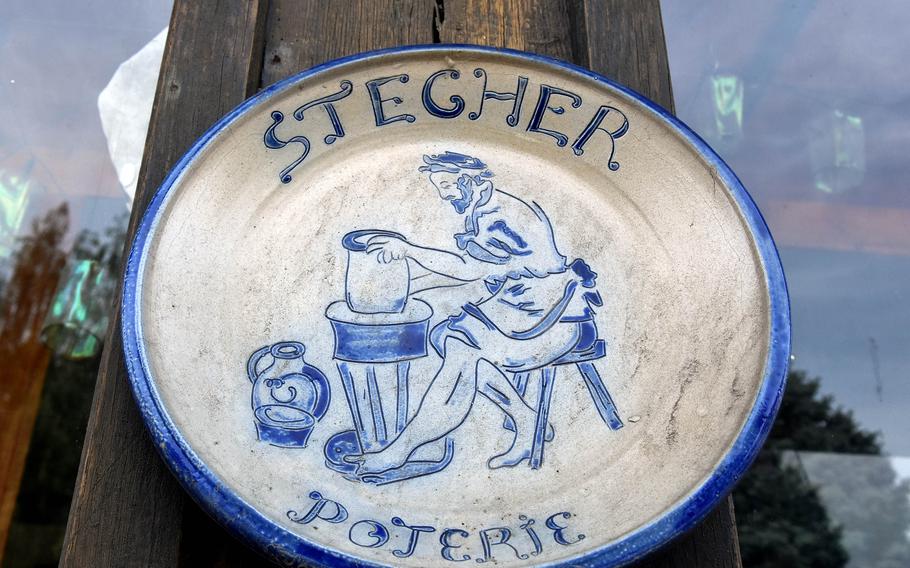
A ceramic plate hangs on a wooden post outside Pascal Stecher’s pottery studio on a quiet street in Betschdorf, France. The village is famous for its Alsatian potters, who for generations have created gray stoneware with cobalt blue patterns. (Jennifer H. Svan/Stars and Stripes)
When I stopped at Stecher pottery shop, it was hard to tell whether the place was closed for lunch or shuttered for good. The storefront of the ramshackle half-timbered house on the main street displayed pretty pots and stoneware mugs — along with a few cobwebs.
The side-entrance door was locked, so I decided to check back in the afternoon.
On the outskirts of Betschdorf, I met Marie-Line Remmy at Les Gres de Remmy, which is run by her and her husband, Vincent.
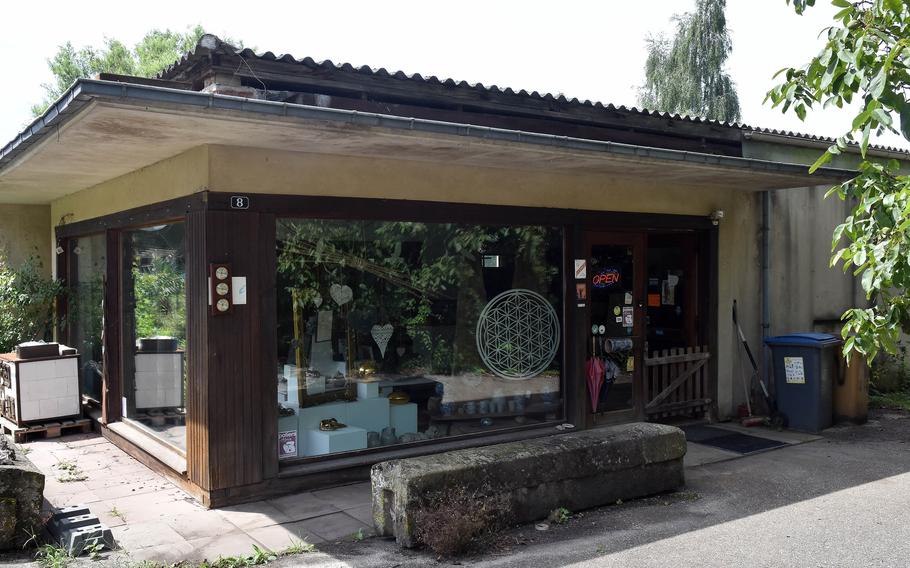
Vincent and Marie-Line Remmy welcome customers to their pottery shop and studio on the outskirts of Betschdorf, France, six days a week. (Jennifer H. Svan/Stars and Stripes)
Remmy showed me the couple’s large workshop stacked with unfinished pots of various shapes and sizes and a wood-burning kiln, where they bake their handmade designs.
They add salt to the oven, which, when combined with temperatures higher than 2,200 degrees Fahrenheit, produces a strong, durable glaze.
It’s why the traditional pottery from Alsace is good for storing and keeping items fresh, everything from wine to mustard and vinegar.
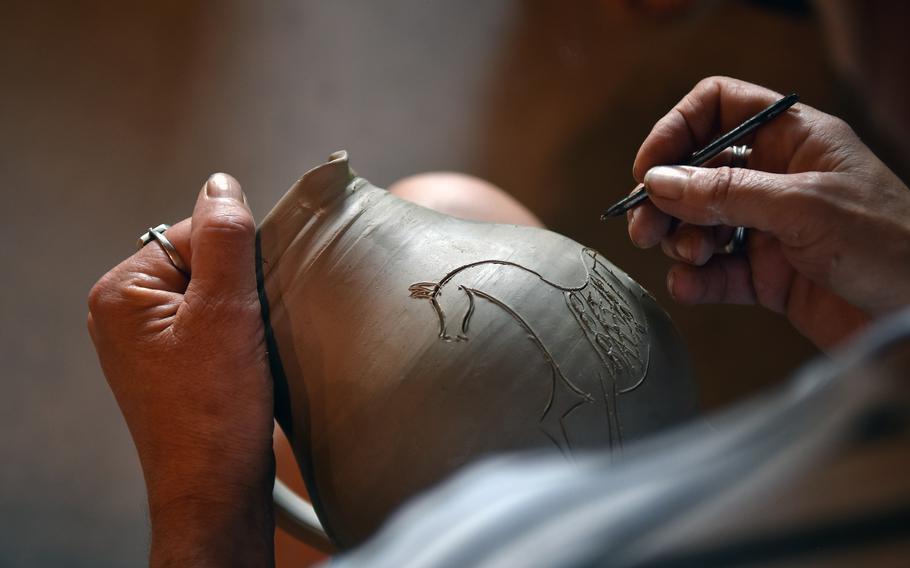
Marie-Line Remmy etches a horse into the soft clay of a pot in the family’s pottery workshop in Betschdorf, France, a small village in the Alsace region known for its gray-blue pottery. (Jennifer H. Svan/Stars and Stripes)
Remmy invited me to watch as she picked up an unfinished piece and etched a horse into the soft clay. She then filled in cobalt oxide to the design with water and a brush.
She gave me a brochure with a dated map that listed a total of eight pottery houses in Betschdorf, noting that the number now was fewer and circled which ones she thought might still be open.
Poterie Fortune Schmitter was one, and it looked to be thriving. The family has been making pottery for seven generations, said a business card. A boutique in a half-timbered house next to an even larger workshop sold a nice variety of pieces, from clay animals to stunning vases with bright blue flourishes, flowers and other designs.
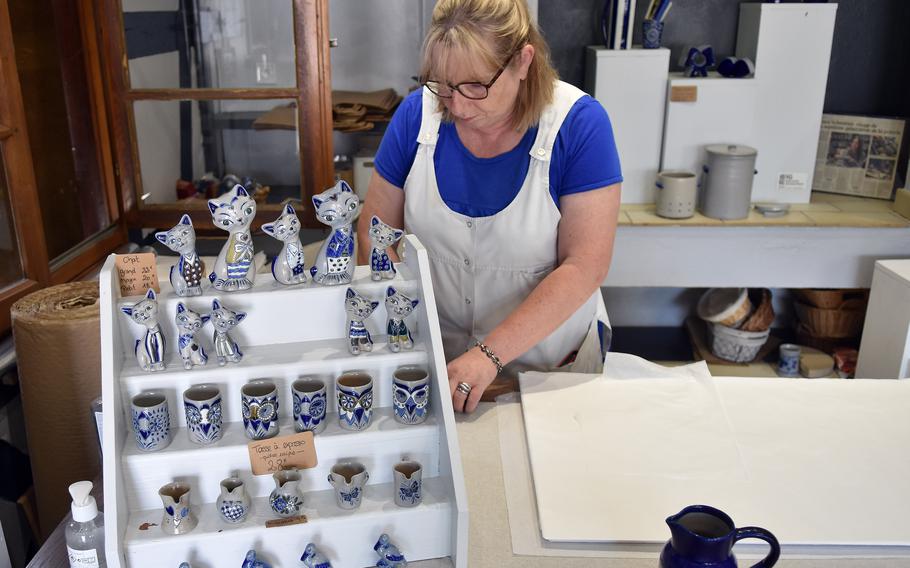
Ceramic cats, storks and owl faces carved into mugs are among some of the unique works found at Fortune Schmitter, a family of potters that has been making gray and blue pottery for seven generations in Betschdorf, France. (Jennifer H. Svan/Stars and Stripes)
Some of the pottery houses don’t keep regular hours, as I discovered when stopping again at Stecher. The door was still locked, but a shirtless older man was in a back lot doing yardwork. He motioned that he would be right there.
A few minutes later, a shirt-wearing Pascal Stecher opened his tiny, one-artist operation and donned an apron as he went back to his workshop. Customers can call or message him ahead of time about opening his shop.
He loves witches and dragons, he said in English, and paints them on bowls and molds their images with exaggerated features into mugs. He’s sculpting a large dragon that he doesn’t plan to sell.
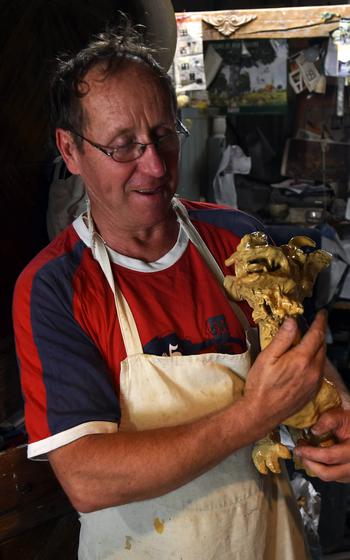
Potter Pascal Stecher holds one of his prized creations, a dragon he created in his tiny workshop in Betschdorf, France. Stecher often incorporates the themes of fantasy and sorcery into his work. (Jennifer H. Svan/Stars and Stripes)
I asked about a strangely shaped bowl with a lid and odd-angled handles. It’s meant to look like a witch’s pot, he said, and it’s the only one in the shop.
I ended up buying something at each place, including Stecher’s sorcery bowl. Prices weren’t flea market cheap, but some of the smaller pieces that I encountered cost between 25 and 35 euros.
Each item has an artist signature or stamp etched on the bottom, certifying its authenticity as a unique Betschdorf piece.
If you want to fill up your cupboards even more, head eight minutes down the road to Soufflenheim, which is known for its more colorful crockery used in baking. Expect to wander there too: The village has more pottery shops than Betschdorf, but they are more spread out.
Also, be sure to bring cash. Some places in Betschdorf took credit cards, but I had to scrape together my last coins to buy Stecher’s witch’s pot, which now makes for a great kitchen conversation piece.
On the QT
Directions: The village is about 56 miles south of Kaiserslautern in France. The GPS addresses for two pottery shops with regular hours: Les Gres de Remmy, Rue de Soufflenheim 8, Betschdorf; Poterie Fortune Schmitter, Rue des Potiers 47, Betschdorf. Pascal Stecher’s shop is a few houses away from Schmitter at Rue des Potiers 43.
Costs: Parking is free.
Food: There is one convenience store in Betschdorf serving sandwiches, drinks and a few pastries. There’s also a cafe open Wednesday through Sunday. Otherwise, food options are limited.
Hours: Les Gres de Remmy, Monday to Saturday, 10 a.m.-1 p.m. and 2-6 p.m.; closed on Sunday. Poterie Fortune Schmitter, Monday to Friday 9 a.m.-noon and 2-6 p.m., Saturday 10 a.m.- noon and 2 p.m.-5 p.m.; closed on Sunday.
Information: Online: potiersalsace.com; poterie-schmitter.com. Call or text Pascal Stecher in advance at +33 641-575002 about opening his shop.